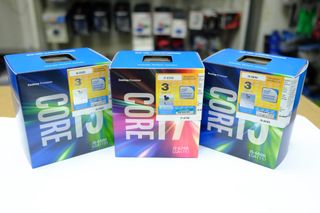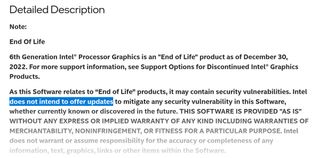Intel Skylake iGPUs Reach End of Life Status
These 2015 vintage processor iGPUs had been on legacy support since last summer.

Intel’s Skylake integrated graphics has reached end-of-life (EOL) status, according to official Intel documentation spotted today by TechPowerUp. Many recognize Skylake as the 6th generation of Core processors, but the family launched with 9th generation iGPUs that will no longer benefit from driver updates, even if a critical issue comes to light.
However, the EOL of Skylake graphics isn’t that surprising. For users of these systems, it will likely mean very little in practice unless a gaping security vulnerability is found in the old drivers. Users of discrete graphics cards will be less worried by this EOL news, as they can disable the iGPU in BIOS, avoiding the Intel graphics driver software.
Introduced in 2015, Intel’s Skylake CPUs started to feel decidedly vintage when Windows 11 arrived with its Intel 8th Gen Core or newer architecture requirements. Last summer, we reported on Intel ending day-0 GPU driver support for 10th gen and older CPUs, with Skylake at the bottom of the list of generations remaining on legacy support. Now that Skylake has dropped off the legacy list, Kaby Lake chips are on the bottom rung of the ladder, waiting to be allocated a plot in silicon heaven.
Intel’s 7th Gen Core Kaby Lake CPUs debuted with Intel Gen 9.5 integrated graphics. Thus, it might be harder to EOL Kaby Lake, as the same graphics architecture persisted through 8th, 9th, and 10th Gen Core processors.

The last regular iGPU driver release available for Skylake users is version 31.0.101.2115, from December 2022. This legacy driver is available here, supporting various editions of Windows 10 & 11, with the Skylake EOL notice in full.
As noted above, the EOL news probably has little consequence for desktop Skylake system users. However, this news and Intel’s legacy driver change last summer might devalue 10th Gen Core and older systems relying on iGPUs with few or no options for a GPU upgrade (e.g., laptops, AiOs or mini PCs). We must also remember that Windows 11 kicked many otherwise serviceable machines into a kind of upgrade limbo. We don’t know what Windows 12 requirements may be regarding CPU, GPU, security, connectivity, RAM, storage, etc.
Stay on the Cutting Edge
Join the experts who read Tom's Hardware for the inside track on enthusiast PC tech news — and have for over 25 years. We'll send breaking news and in-depth reviews of CPUs, GPUs, AI, maker hardware and more straight to your inbox.

Mark Tyson is a Freelance News Writer at Tom's Hardware US. He enjoys covering the full breadth of PC tech; from business and semiconductor design to products approaching the edge of reason.
-
punkncat I noticed this during an update over the weekend. The previous iGPU driver was labeled as 6-10th gen and the update driver 7-10.Reply -
InvalidError AFAIK, Intel has already practically abandoned anything older than Xe. Dropping Skylake from legacy IGP driver support is little more than a formality.Reply -
bit_user Reply
Some Intel CPU models have a 10-year availability window. I don't know that their support window extends for that entire time, but I'd point out that Intel is still accepting orders for several Skylake models.InvalidError said:AFAIK, Intel has already practically abandoned anything older than Xe. Dropping Skylake from legacy IGP driver support is little more than a formality.
For instance, the plain old i7-6700 (65 W) isn't listed as discontinued.
https://ark.intel.com/content/www/us/en/ark/products/88196/intel-core-i76700-processor-8m-cache-up-to-4-00-ghz.html -
anonymousdude Replybit_user said:Some Intel CPU models have a 10-year availability window. I don't know that their support window extends for that entire time, but I'd point out that Intel is still accepting orders for several Skylake models.
For instance, the plain old i7-6700 (65 W) isn't listed as discontinued.
https://ark.intel.com/content/www/us/en/ark/products/88196/intel-core-i76700-processor-8m-cache-up-to-4-00-ghz.html
I imagine it's for replacement parts for OEMs so they can fulfill their service contracts. And for whatever other mission critical environment they might be using it in. -
bit_user Reply
They're all chips on the IoT Group's supported list, I believe. They're meant to be embedded in machinery of the sort which doesn't have a refresh cycle as short as normal PC desktops.anonymousdude said:I imagine it's for replacement parts for OEMs so they can fulfill their service contracts. And for whatever other mission critical environment they might be using it in. -
InvalidError Reply
You can continue supplying parts for clients on long-term supply agreements but cease driver development beyond security-critical patches.bit_user said:Some Intel CPU models have a 10-year availability window. I don't know that their support window extends for that entire time, but I'd point out that Intel is still accepting orders for several Skylake models.
Most Popular


